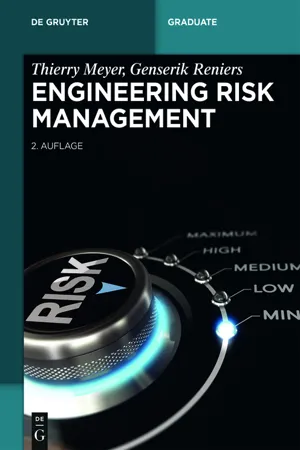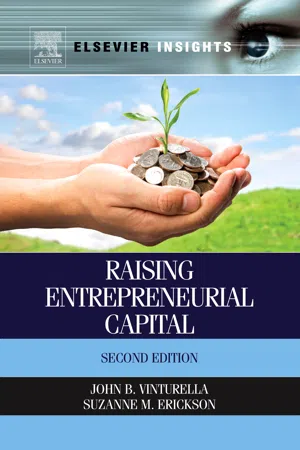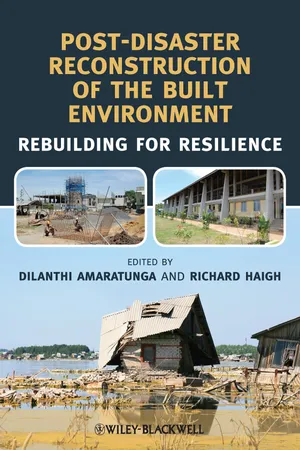Economics
Risk Reduction
Risk reduction refers to the process of minimizing the likelihood and impact of potential losses or negative outcomes. This can be achieved through various strategies such as diversification, insurance, and hedging. In economics, risk reduction is an important concept for individuals, businesses, and governments to manage and mitigate financial risks.
Written by Perlego with AI-assistance
Related key terms
4 Key excerpts on "Risk Reduction"
- eBook - ePub
- Thierry Meyer, Genserik Reniers(Authors)
- 2016(Publication Date)
- De Gruyter(Publisher)
5Risk treatment/reduction5.1Introduction
Risk Reduction encompases all strategies whose goal is to limit risks and damages related to a specific domain. Risk Reduction is the promotion of health and assets. It is empowerment, and to quote a Canadian concept: “Its role is to give the community the means to assume its destiny” [1 ].Techniques of control and Risk Reduction aim to minimize the likelihood of occurrence of an unwanted event (taking into account the exposure to risks leading to the event) and the severity of potential losses as a result of the event or to make the likelihood or outcome more predictable. They could be listed as–Substitution: replacing substances and procedures with less hazardous ones, by improving construction work, etc. –Elimination of risk exposure: consisting of not creating or of completely eliminating the condition that could give rise to the exposure.–Prevention: combining techniques to reduce the likelihood/frequency of potential losses. Observation and analysis of past accidental events enable the improvement and intensification of prevention measures.–Reduction/ mitigation: assessing techniques to reduce the severity of accidental losses when an accident occurs. –Measures applied before the occurrence of the event (often also have an effect on the likelihood/ frequency). –Measures applied after the occurrence of the event (often aim to accelerate and enhance the effectiveness of the rescue). –Segregation: summarizing the techniques that are to minimize the overlapping of losses from a single event. It may imply very high costs. –Segregation by separation of high-risk units. –Segregation by duplication of high-risk units. Another option is so-called ‘Transfer’, risk transfer by –Contractual transfer of the risk financing, essentially insurance. –Risk financing by retention (auto financing), financial planning of potential losses by your own resources. –Alternative risk. The alternative risk transfer (ART) solutions comprise both elements of auto financing and contractual transfer and so cannot be classified in any of the above categories. - eBook - ePub
- John B. Vinturella, Suzanne M. Erickson(Authors)
- 2013(Publication Date)
- Elsevier(Publisher)
Risk management is a core value in many firms. Over 800 of the Fortune 1000 firms are members of the Risk and Insurance Management Society, Inc. (RIMS). RIMS is the leading risk management organization in the United States. Risk management contributes to the continued existence of economic entities, both for-profit and not-for-profit, by allowing those entities to maintain their productive resources, to meet their business objectives, and to provide their critical services. Peter Drucker, the renowned management scholar, notes that the practice of risk management is a hallmark of a developed economy.Relationship of Risk Management to Financial Management
Financial theory holds that the value today of the future earnings of an economic enterprise will be maximized if periodic fluctuations in those earnings (i.e., risk) are minimized. One of the purposes of risk management is to eliminate or to minimize those periodic fluctuations in earnings. In other words, the planning and budgeting processes are optimized if risk management strategies are in place to either prevent or offset the negative effects of random events. The availability of financial products (e.g., insurance) to offset those negative effects makes entrepreneurs more willing to accept risk in areas that they understand and in which they possess a comparative advantage. Thus risk management promotes financial soundness and the market economy.The Risk Management Process
The risk management process is a series of ordered steps leading to the accomplishment of risk management objectives. Those risk management objectives support the overall objectives of the economic entity. It is important to focus on the notion that risk management is a process, an ongoing activity. It is not enough to have an annual Risk Management Day or Risk Management Week. Risk management must be part of the continuing operations of the economic entity for the optimum results to occur. Here are the steps in the risk management process. - eBook - ePub
Quality in the Era of Industry 4.0
Integrating Tradition and Innovation in the Age of Data and AI
- Kai Yang(Author)
- 2023(Publication Date)
- Wiley(Publisher)
[19] . By integrating risk management into strategic planning, organizations can enhance their uncertainty navigation ability, protect their interests, and seize opportunities.As we explore risk, we will delve into various risk types that individuals and organizations encounter, each with unique challenges and considerations. From financial and operational risks to technological, environmental, and societal risks, understanding these diverse risk dimensions allows us to develop tailored approaches for risk mitigation and response [20] .As we commence this journey to understand risk, our aim is to equip ourselves with the knowledge, tools, and insights for effective uncertainty navigation. Embracing risk as an integral part of our decision‐making processes enables informed choices, opportunities, and enhanced adaptability in an ever‐changing world. Through this exploration of risk, we can unlock the potential for growth, innovation, and resilience in both personal and organizational contexts.7.2.1 Definition of Risk
Risk management has appeared in scientific and management literature since the 1920s. It became a formal science in the 1950s [2] . Most of the research was initially related to finance and insurance.Risk, in a scientific context, is defined as the probability or likelihood of a negative event or outcome occurring due to a particular action, decision, or event, combined with the magnitude of the consequences should the event occur.It is typically represented quantitatively as a combination of the magnitude of potential loss (consequence), and the probability (likelihood) that the loss will occur. It can be expressed mathematically as:(7.1)In this formula:- “Probability” refers to the likelihood of an event occurring. It is often represented as a value between 0 and 1, where 0 indicates that the event will not occur and 1 indicates that the event will certainly occur.
- “Impact” refers to the magnitude or severity of the consequences if the event does occur. The impact can be quantified in various ways depending on the nature of the risk, such as financial loss, number of people affected, or extent of environmental damage.
- eBook - ePub
Post-Disaster Reconstruction of the Built Environment
Rebuilding for Resilience
- Dilanthi Amaratunga, Richard Haigh(Authors)
- 2011(Publication Date)
- Wiley-Blackwell(Publisher)
and implemented to take into account and eliminate possible disaster to the fullest extent. Furthermore, it is important to control the aforementioned variables (McEntire, 2001), which interact to increase disaster vulnerabilities, to achieve disaster Risk Reduction. In this context, UN/ISDR (2009) defines disaster Risk Reduction as the concept and practice of reducing disaster risks through systematic efforts to analyse and manage the causal factors of disasters including through reduced exposure to hazards, lessened vulnerability of people and property, wise management of land and the environment, and improved preparedness for adverse events. This definition confirms that invulnerable development or vulnerability management is the prerequisite of disaster Risk Reduction.Incidentally, disaster Risk Reduction through minimising vulnerabilities to avoid (prevention) or to limit (mitigation and preparedness) the adverse impacts of hazards has been identified as a better approach to face disasters than post-disaster responsiveness (Yokohoma Strategy of Disaster Reduction, 1994; Sahni and Ariyabandu, 2003). According to Goodyear (2003), creating a culture of prevention is essential to address the hazards and the adverse consequences of a disaster. Thus, disaster reduction is all about taking measures in advance to address Risk Reduction involving environmental protection, social equity and economic growth, the three cornerstones of sustainable development, to ensure that development efforts do not increase the vulnerability to hazards (UN/ISDR, 2002). Accordingly, the next section looks into the interrelationship between disaster Risk Reduction and sustainable development more closely.16.4.2 Interchangeable terms: sustainable development goals and vulnerability reductionAs illustrated in previous sections, development activities have a significant interrelationship with disaster Risk Reduction since development can increase or/and decrease disaster vulnerability (McEntire, 2004). Therefore, it is essential to take disaster Risk Reduction into consideration in all development activities. As UNDP (2004) emphasises, although disaster risk is not inevitable, it can be managed and reduced through appropriate development policy and action. Thus, disaster Risk Reduction policies and measures need to be implemented to build disaster resilient societies and communities, with a twofold aim (UN/ISDR, 2003); to reduce the level of risk in societies, while ensuring, on the other hand, that development efforts do not increase the vulnerability to hazards but instead consciously reduce such vulnerability.
Index pages curate the most relevant extracts from our library of academic textbooks. They’ve been created using an in-house natural language model (NLM), each adding context and meaning to key research topics.



